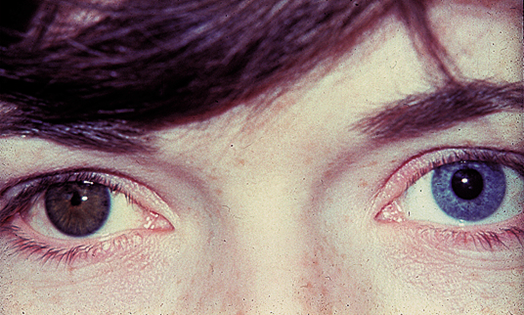Diseases
Anisocorie

Synonym(s)
Pupillary Asymmetry - Pupillary Inequality
Definition
The pupil, which is the dark centre of the eye, dilates in darkness and contracts in light. Usually, the two pupils are the same size and react identically to light, but sometimes this is not the case. Anisocoria is then defined as the existence of two pupils of unequal size. This pupil disorder may be harmless or indicate a serious pathology, and should not be ignored.
Causes
Physiological anisocoria
In most cases, anisocoria has a physiological cause, resulting in a difference in size between the two pupils that is considered natural (approximately ≤ 1 mm). This normal and harmless variation affects 20% of us.
Pathological, mechanical and pharmacological anisocoria
There are, however, other frequent causes of anisocoria, which are non-physiological.
- If an asymmetric pupil appears as a result of an illness, it is called ‘pathological anisocoria’. This is particularly the case when the condition is associated with an inflammatory disease such as uveitis (inflammation of the iris), a nervous system disorder such as Claude Bernard-Horner syndrome (a neurological condition that affects the side of the face) or certain forms of glaucoma.
- If an asymmetric pupil is linked to an ocular lesion or congenital anomaly, it takes the form of ‘mechanical anisocoria’.
- If it occurs after taking medication or an illicit substance, it is known as ‘pharmacological anisocoria’.
Symptoms
Anisocoria in itself, when benign, often causes no symptoms apart from the difference in size between the two pupils, which is often only noticed during a medical examination.
In some cases, the sufferer may experience sensitivity to light or difficulty in focusing on nearby objects, but this is not a cause for concern. On the other hand, eye pain, neck pain, reduced vision, drooping of the eyelid (ptosis), double vision or headaches are all symptoms associated with this difference in pupil size that should alert the clinician and patient to its pathological nature.
Diagnosis
The doctor's first aim is to determine whether the difference in pupil size has always existed or whether another, possibly serious, medical cause is the first manifestation.
Secondly, a clinical examination is carried out to determine which pupil is affected by the disorder. To do this, the doctor observes the size of the pupil and its response to light, first in a dark room, then in a lighted one. Eye movements and accommodation are tested and ocular structures inspected for tissue abnormalities and ptosis.
- If the difference in pupil size is greater in the dark, the doctor can then determine that the smaller pupil is abnormal. Common causes include Claude Bernard-Horner syndrome and physiological anisocoria.
- If, on the other hand, the difference in size between the pupils is greater in the light, the doctor can determine that the larger pupil is abnormal. A paralysis of the3rd cranial nerve may then be suspected in the presence of reduced eye movements and ptosis.
- An examination of the eyeballs may be carried out to assess the presence of other ocular symptoms. Any history of cranial or ocular trauma is also investigated, as are certain symptoms that might suggest a cause, such as birth defects, chromosomal abnormalities or neurological symptoms, for example.
The doctor's primary aim is to determine whether the difference in size between the two pupils has always existed or whether another cause, such as medication, exposure to a chemical substance or some other condition, may be at the root of this phenomenon.
Treatments
Anisocoria itself does not require treatment, unlike its causes, which must be assessed and treated.
In the case of pathological anisocoria, treatment differs according to the disease diagnosed, and may involve medication or surgery.
Surgery may also be indicated for mechanical anisocoria.
In the case of pharmacological anisocoria, the drug in question should be discontinued.
References
- https://www.msdmanuals.com/fr/professional/troubles-oculaires/sympt%C3%B4mes-des-troubles-ophtalmologiques/anisocorie#Bilan_v951736_fr
- https://www.msdmanuals.com/fr/accueil/troubles-oculaires/sympt%C3%B4mes-des-maladies-des-yeux/diff%C3%A9rence-de-taille-entre-les-deux-pupilles
- https://www.opticiensparconviction.fr/qu-est-ce-que-l-anisocorie-symptomes-et-causes-d-une-pupille-asymetrique
content reviewed and revised on 16.01.2025

